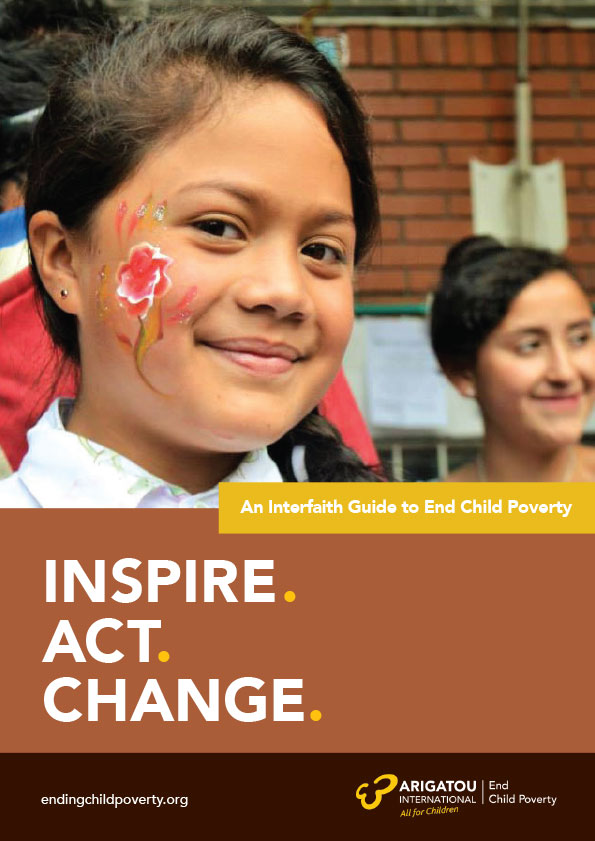Documents
An Interfaith Guide to End Child Poverty: Inspire. Act. Change.
Religious communities and organizations have unique resources. These include their spiritual values, social capital, and moral assets. By working together in partnership with like-minded organizations, we believe in mobilizing resources to reduce poverty at grassroots and global level. We have a three-pronged strategy:
- Mitigating the root causes of poverty in the human heart through theological reflection, prayer, and action;
- Combating the structural causes of poverty through interfaith advocacy and lobbying;
- Accompanying, supporting or undertaking replicable and sustainable grassroots projects, all targeting alleviation of Child Poverty.
This guide has ten chapters, each dealing with a specific theme that analyses and relates various aspects of Child Poverty. The Guide is relevant and engaging to various audiences, for different purposes and different contexts. The guide can, for instance, be used as a resource too;
- Build the leadership capacity of an organization or institution;
- Function as a training tool for adults and youth working with children;
- Act as a study tool for educational purposes in academic environments; and
- Provide practical tools and tips to help plan events and projects to alleviate Child Poverty.
Chapter 1: Introduction: This chapter introduces and provides an overview of the Guide, its purpose, and usage.
Chapter 2: Understanding Poverty: This chapter reflects on different definitions of poverty including the distinction between “absolute” and “relative” poverty. The chapter further reflects on the multidimensional measures of poverty and points out that, in order to be effective, any poverty eradication initiative ought to go beyond conventional economic approaches to address poverty. Noting that theories on the causes of poverty are the foundation upon which most poverty reduction strategies are based, this chapter gives a snapshot of three theories that attempt to explain the existence of poverty;
- Individual Deficiencies Theory of Poverty
- Cultural Theories of Poverty
- Structural Theory of Poverty.
Finally, this chapter ends by demonstrating the multidimensional problem of child poverty and the impressions of children and youth on poverty.
Chapter 3: Root Causes and Drivers of Child Poverty: This chapter reflects on how different drivers can contribute to and exacerbate child poverty. These include inequality, corruption, violence and violent conflicts, climate change and the Environment. The chapter further draws a nexus between child poverty and gender dynamics, lack of health facilities and education.
Chapter 4: Children, Religion, and Spirituality: Religious adherence encourages children’s participation towards mitigating the impact of poverty. While the abuses of religion and the strife caused by sectarianism are clear, a religious belief or affiliation and religious rituals can provide support and inner resilience to children in times of difficulty such as in situations of poverty or other deprivation.
Chapter 5: Religious Reflections on Children and Poverty: This chapter contains inspirational reflections from the Buddhist, Christian, Hindu, Jewish, Muslim and Sikh faith traditions on mitigating child poverty.
Chapter 6: Overview of Children’s Rights: This chapter provides an overview of Children’s Rights that specifically address Child Poverty – including the Right to Non-discrimination; the Right to life, survival and development; The Best interests of the Child: and Respect for the views of the Child. All these rights originate from the Convention on the Rights of the Child (CRC) and Child Poverty. Eradicating Child Poverty in all its dimensions is one of the most important and urgent human rights issues of the 2030 global agenda. There are two SDG Goals outlined in the section’s content.
Chapter 7: Faith-Inspired Approaches to Ending Child Poverty: This chapter reflects on some faith – inspired approaches to end child poverty. Covered in this chapter are the role of religious communities in poverty eradication; universal values shared by religious communities; added value and strengths of faith-inspired organizations; communities and religious leaders in combating poverty; theological reflection, prayer and action; advocacy and lobbying; grassroots mobilization and initiatives; Global coalitions; research; evidence and knowledge generation.
Chapter 8: Community Mobilization to End Child Poverty: This chapter reflects on the mobilization of communities to end child poverty. The issues discussed include the different groups of a community and the contribution each of them can make. They include religious leaders, theologians and educators; children and the youth; and ordinary men and women in society. It examines strategies for mobilizing community members, organizing them into levels of community participation as well as guiding principles.
Chapter 9: Building Partnerships to Address Child Poverty: This chapter highlights the need to work with key partners and stakeholders in fighting Child Poverty including parents, guardians, and caregivers; inter-religious organizations; the role of the Government; Civil societies; global coalitions; the United Nations and its key Organs; and the Media.
Chapter 10 Tool Box: Participatory Training Methods, Making Your Work Relevant and Advocacy and Communication Tools. This chapter outlines the principles of working with different groups of people and the ethical considerations to make when facilitating training for each of these groups. The chapter further looks at useful approaches to use as teaching aids. The chapter also provides tips on how facilitators can achieve effective training sessions using effective teaching methodology and demonstrating appropriate behavioral characteristics.
The chapter provides tips on advocacy communication and media tools; different forms of media to communicate with; and the tools for media engagement.
Our anticipation is that the information provided in this Resource Guide would motivate you and equip you as an individual or as an organization towards ending child poverty.



